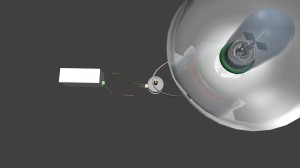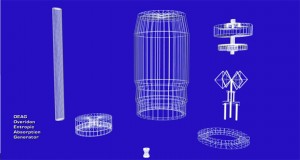
Connections and Heuristics are the roots of Cybernetics…films portraying cyborgs don’t give the whole picture
Yesterday, I finished reading an excellent book called, Alternatives to Economic Globalization (A Better World is Possible) which dealt with several important issues. Easily my favorite aspect of the book was the final set of chapters which focused on environmentally friendly solutions to economic needs and problems. This has been a major focus in my own research and even though this book was written in 2002…the concepts discussed in these final chapters were applicable today.
Before I delve too deeply into that subject, I want to discuss a concept that has been misconstrued in the media. It’s the idea of cyborgs. The term cyborg immediately brings forth ideas like Terminator robots and Robocops into someone mind. But these beings have actually very little to do with modern cybernetics. And when the subject of cyberethics is brought up, murderous robots tend to mess up the entire mental equation. And people are quick to dismiss concepts like cyberethics simply because of their names.
This is extremely unfortunate because cyberethics is one of the most important concepts when discussing and discovering new methods for environmental sustainability and innovation.
Let’s define these key terms so that this article has a strong foundation for deeper understanding of cyberethics and its potential for saving lives and money in our modern world.
First cybernetics is a term which is primarily concerned with systems that have active feedback mechanisms. One example of a cybernetic system would be a system of checks and balances within a healthy nation-state government. For example, in the United States of America, we have a Judicial, Legislative and Executive branches of government. These branches of government attempt to perpetuate the existence of that very government by making nation-state level decisions, creating laws and enforcing/interpreting those laws. If one branch of government becomes incapable of handling a problem, the other branches receive feedback from the media, public opinion, other lawmakers, civil disobedience which threatens the perpetuity of the government and of course many other mechanisms which exist in modern society.
The thing to remember is that cybernetics does not have to be about something related to computers.
Cyberethics takes cybernetics to a whole new level. Cyberethics is a way of thinking which puts heuristics feedback systems, resource optimization, and survival factors at the forefront of system creation. If one was to design a house with cyberethics in mind, he or she would probably want to make the most energy-efficient, good-looking and comfortable house possible.
In the book Alternatives to Economic Globalization, the authors bring up examples of South American cities which have low carbon footprints and high standards of living. I truly enjoyed reading about these examples and applaud the mayors and citizens which make such accomplishments possible.
But guess what? The year isn’t 2002 anymore.
In fact, 2014 is just around the corner. When I talk to people around town, no one really says, “Yep, it’s 2014. Who cares?”
Sorry, almost everyone I talk to says something like this, “Wow, I can’t believe it’s 2014 already. Time really flies.”
Why is this?
Has our perception of time changed in our modern society? Is saying time flies a simple politically correct conversation starter? I think there is much more to this than we think.
In the book Alternatives to Economic Globalization there is a constant recurring theme of taking power back from corporations and giving it to small-scale ownership and small-scale responsibility.
Even though the writers are absolutely correct, that small-scale environments are more energy efficient and environmentally friendly…they’re missing one important fact. Big corporations aren’t going to give up their place in the world without a fight. And since big corporations have wealth, influence, support systems, financial leverage, political inroads and many other methods to maintain their power…most of the first half of the book is just absolutely correct yet wishful thinking. It’s nothing personal but get real.
The reason why large corporations and large fossil fuel consuming countries are slow to change is because they’re big. Big things are heavy, big things move slowly. Why would governments and corporations be any different?
“If it ain’t broke, don’t fix it!” Have you ever heard that before?
Well, in the bureaucratic sectors the motto is, “If it is broke, but if it still makes somebody money…then you’ll need to get approval to fix it because that’s your issue and I’m not putting my position on the line to help you. PS: This wasn’t my fault anyway, the problem originated from the other sector which is the root cause.”
It’s just a game of Pass the Bean and it’s not meant to frustrate people. It’s just the way things work in the real world. Well, the real world for many large sectors of business and government that is…but things are slowly changing day by day. And the root cause of that has to do with the bottom line.
As markets become saturated and consumable resources become more scarce, bureaucrats are faced with tough choices. It’s kind of like how treasure troves of old precious coins are reported to be found in dead people’s houses every few years in the local newspapers. It always happens because somewhere, someone was hording a whole bunch of something. And they weren’t doing much with it either…just collecting it. It happens all the time.
The problem is that the very act of hording something valuable without a way to circulate and grow wealth within a system can cause unhealthy behaviors on multiple levels. The Alternatives to Economic Globalization book touches on this when it discusses dependence on foreign oil and the support systems required to keep this system in place including wars etc. It’s a really good point because since our demand is so ridiculously high for a certain product, support industries can be drastically affected by changes in both consumption and production of something like oil.
One of my favorite movies is “Chain Reaction” with Morgan Freeman and Keanu Reeves. In this film a group of scientists and researchers come up with a way to use sonoluminescence in order to create excess energy. But Morgan Freeman’s character warns the chief scientist that the world wasn’t ready for this technology to become public so he had the scientists killed. (It’s not a spoiler this happens in the beginning of the movie so calm down.)
This makes sense: Large systems are the most vulnerable to rapid change.
But here’s the problem…actually it is less of a problem than it is an opportunity.
The advent of the open source movement in conjunction with the internet has allowed innovators to simple solve problems on their own or in small groups. If you don’t like something in your world. Change it. If you want to see more of something that isn’t in your world. Make it.
Use search engines aggressively. Use video repositories aggressively. If you are the kind of person who is comfortable with social networking, use it the maximum to learn what you need to know…and then promote your work to make a difference.
Alternative to Economic Globalization came out in 2002 and there wasn’t even a fraction of a the amount of information on the internet as there is now. So of course this book is going to use more of a “protest and force reform” type of solution to modern economic problems. But we are in an entirely different world now.
I wanted to learn Actionscript 3.0 back in 2004, so I bought 2 books and learned the programming language.
Now I want to learn Android development so I studied and completed the Javascript tutorials on Codecademy.com and I’m watching the video series below that deals directly with Android development and how it uses Java. I thought that Java would be a big jump away from Actionscript and Javascript and honestly…it isn’t that bad. It’s just a little bit more complicated with more tools, cogs and key-terms. But it is definitely within reach.
What we’re talking about is crafting our own retirements. Cleaning our environments by not being satisfied by the status-quo. Instead we can challenge our own lethargy and learn more than one profession in a lifetime. No one should make fun of someone for being a family man and doing the same job for 60 years. And on the same note no one should mock a dreamer who tries out several different jobs and professions. We all have our place in modern society and it is growing and becoming stronger every day because of our ability to share our adventures!
So feel good about yourself and realize that we have much more in common with each other than we think. We all want extra bucks in the pocket. We all want to feel safe and satisfied. That is completely normal and realistic. The trick is share ideas which can save innovators time…and sharing friendly support which can inspire perseverance and productivity!
Thank you so much for reading and have an excellent week.
-Tyler
